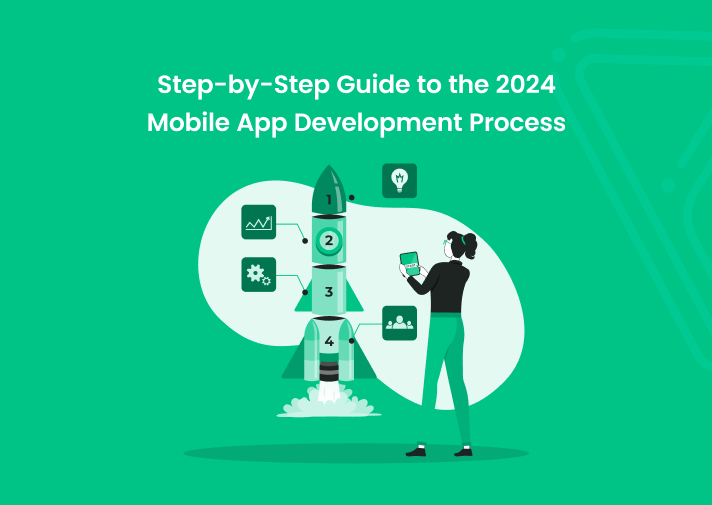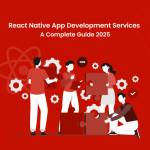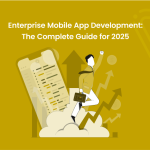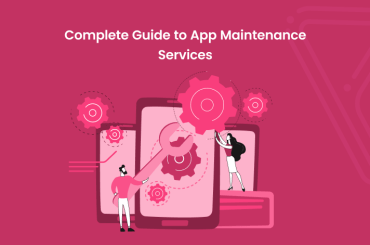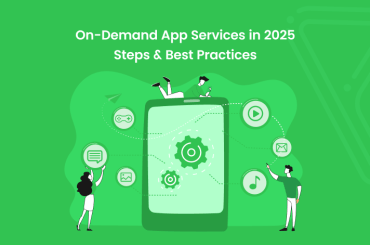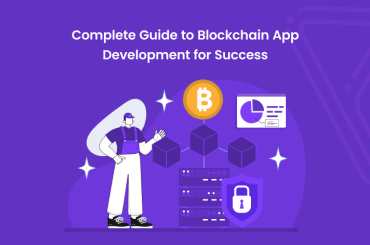Ever wondered how your favourite mobile apps are developed? Or maybe you’re curious about what goes into the App Development Process to turn your own app idea into reality? It might look daunting to begin with, but we have you covered.
This blog is a guidance on explaining the complete App Development Process with detailed steps. By the end, you’ll have a clear understanding of how apps are built and what goes into making them successful.
By the end, you’ll have a clear understanding of how apps are built and what goes into making them successful. Ready to dive in and learn more? Let’s get started!
What is the Mobile App Development Process?
The Mobile App Development process refers to a series of steps followed by developers to build mobile applications. The journey starts through strategy and goes beyond design, development, testing & deployment. To make sure the program works as planned, each step is essential.
The Process of App Development is Systematic and Iterative. The developers keep improving the app according to its technical requirements and customer feedback. They do so to make sure the end-product is refined and user friendly.
By following the best practice for App Development, businesses can develop an app that makes waves in its market. A well-set development plan helps in decreasing the mistakes and hence making it efficient so that when your application launches its a hit.
Is Developing a Mobile App Still Worth It in 2025?
In 2025, it is still quite beneficial to invest in the app development process. There are billions of people using mobile apps for communication, shopping and others which makes direct access to our end consumers. This becomes a massive opportunity for engagement and revenue.
The demand for creative and well-designed apps has never been higher, despite fierce competition. Businesses can create apps that promote growth and loyalty by effectively using the App Development Process. App development is becoming more and more important as mobile commerce and the Internet of Things grow.
Apps offer unique opportunities to connect with users and solve their problems in real-time. Among numerous industries, a well-executed process of App Development can turn out to be the boon for businesses in the long-run.
What Are The Key Mobile App Development Stats in 2025
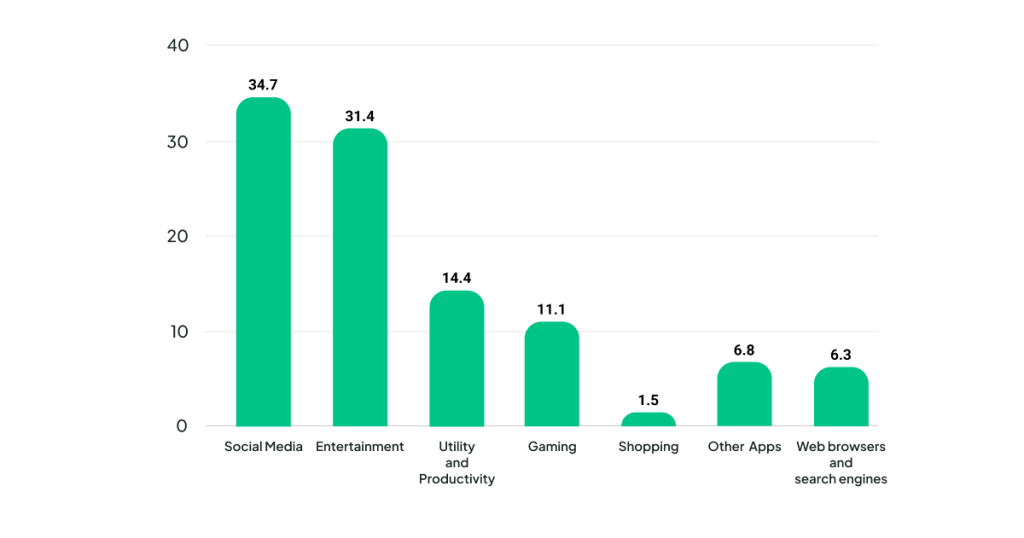
In 2025, the rise of mobile apps will influence digital interactions, making the App Development Process more relevant than anything else. Users spend 90% of their mobile time on apps, showing the immense potential for engagement. This trend continues to push businesses toward mobile app investments.
Moreover, the app market is expected to generate over $935 billion globally by 2025. With this data, we can see why investing in the App Development Process will yield some serious financial gains. Mobile apps provide direct access to consumer markets, which promotes growth.
Additionally, 40% of companies also expect to boost their app development budgets. This emphasizes the need of a well-planned App Development Process. Investing in apps is not just a trend; it’s a strategic decision for long-term success.
Top 4 Approaches to the Mobile App Development Process
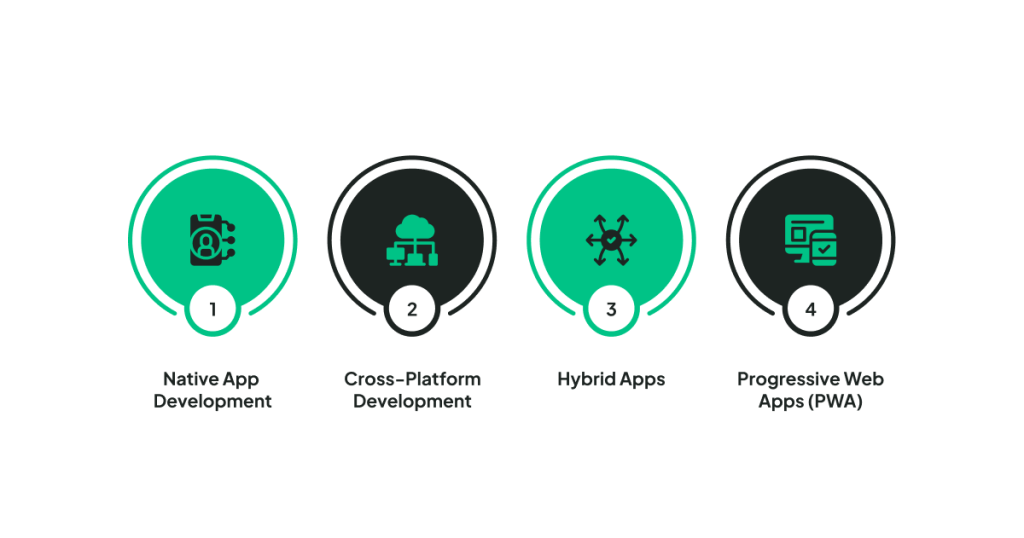
Choosing the right approach to the App Development Process is crucial. There are four primary ways to target mobile devices: native, cross-platform, hybrid, and progressive web apps (PWAs). Each has its own different but complementary advantages depending on what you’re trying to do and who your target audience is.
- Native App Development is ideal for creating highly responsive and platform-specific apps. This is the perfect way to use all of operating system capacity, but it could be very expensive.
- Cross-Platform Development saves a lot of time and money by using a single codebase for several platforms.
- Hybrid Apps combine elements of native and web apps, offering flexibility with some limitations on performance.
- Progressive Web Apps (PWAs) are websites that function like an app, similar to regular apps. They are fast and cost-effective, though they might lack advanced functionalities.
| Approach | Pros | Cons |
|---|---|---|
| Native | Optimal performance, deep integration | Higher cost and development time |
| Cross-Platform | Reduced costs, quicker development | Limited access to platform-specific features |
| Hybrid | Flexible, cost-effective | Lower performance than native apps |
| PWAs | Fast, cost-effective | May lack advanced functionalities |
Best Practices and Challenges in the Mobile App Development Process
The mobile app development process includes using Best Practices while facing challenges to make a great app.
- Focusing on User Experience (UX): Give top priority to developing an interface that satisfies user needs and is both engaging and intuitive.
- Ensure Strong Security: Protecting user data by enforcing security best practices like encryption and data protection.
- Security Risks: Protecting the app from data leaks & online threats.
- Technological Developments: Keeping up with rapidly changing mobile technologies and frameworks.
- Agile Development: Using agile approaches to boost productivity and respond quickly to changes.
- Continuous Testing: Testing the app throughout and after development on all devices to verify its quality output.
- Trend Awareness: Stay updated on mobile trends and evolving user expectations to keep the app competitive.
Essential Factors to consider before you start your mobile app development process
Before beginning into the App Development Process, you must consider several factors. First, identify your target audience’s problems in detail. It would determine the functionality and design of your app.
Secondly, set reasonable timelines and budgets. Since the app development process can be costly and time consuming, proper planning will make you to stay within your limits and build which was expected.
Lastly, think about scalability. Your app should be designed to handle growth, such as increased user numbers or additional features, without major overhauls. Your app will be future-proof if you consider long-term scalability during the app development process.
Key Stages of the Mobile App Development Process
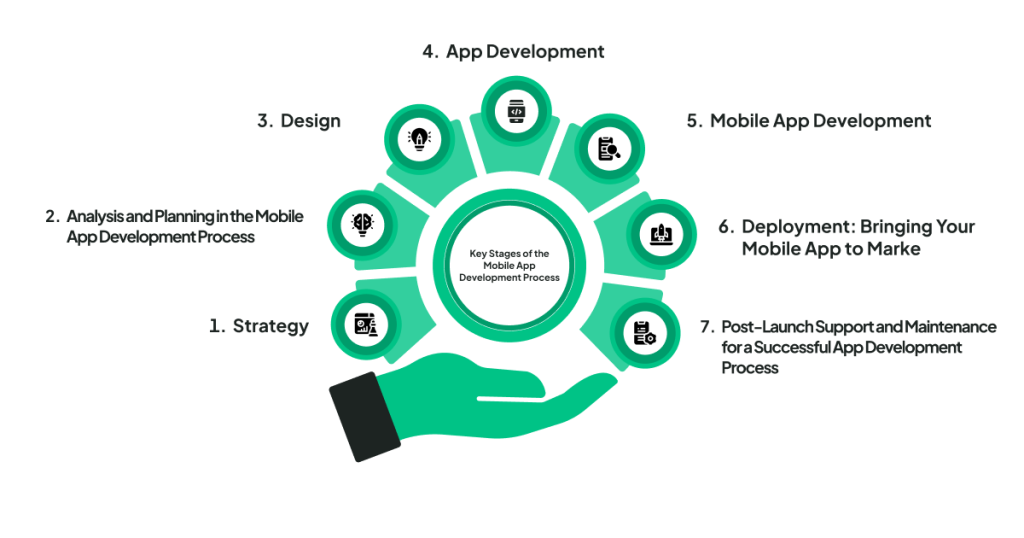
The App Development Process is broken down into seven key stages. Each stage is critical to the success of the final product, ensuring that the app is both functional and appealing to users.
1. Strategy
The entire App Development Process is built upon the strategy phase. In this stage, you outline the goals of your app, who are its target users and what business objectives will it help pursue. Making sure your app stands out in the market by performing intensive research and analysis of competitors is a first step.
A successful strategy gives you a better vision and roadmap. It makes sure that every person in the team agrees on all goals and objectives during an App Development.
This is where you answer important questions like what issues the app will address, how to make money from it and why this could be a part of your greater business strategy.
2. Analysis and Planning in the Mobile App Development Process
You will refine the technical requirements of the app and create a roadmap throughout the analysis phase of the app development process. This includes identifying basic functionality, choosing a platform and setting up the development schedule. A thorough plan helps prevent budget overruns and delays.
Analysis also includes creating workflows and wireframes to ensure that everyone on the team has a clear understanding of the app’s structure. This phase is important to have clear understanding and expectations of the app you are about to build.
A Properly planned App Development Process helps in achieving smooth execution in the later phases, thereby reducing compatibility issues down during development.
3. Design
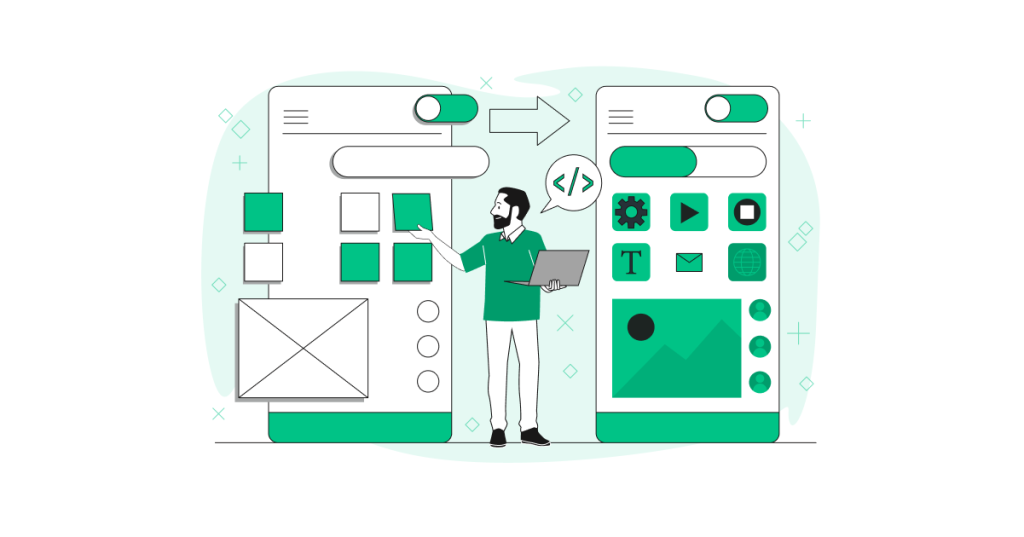
The design phase is where you bring the app’s visual elements to life. The App Development Process here involves creating wireframes, mockups, and prototypes to refine the user interface and user experience.
- Wireframes:
- Create basic layouts that represent the structure of the app.
- Act as prototypes demonstrating how different screens and functionalities would interact.
- Focus on functionality and user flow rather than detailed visuals.
- Style Guides:
- Specify the visual requirements, including color schemes, fonts, and iconography.
- To match the brand’s identity, make sure the app is consistent throughout.
- Act as a quick reference for designers and developers during the App Development Process.
- Mockups:
- Detailed visual designs that incorporate the app’s style guide.
- Display the final look of the app, which includes color schemes and typographies.
- Prior to creation, let stakeholders see how the app will seem and feel.
- Prototype:
- A clickable, interactive version of the that simulates user interactions.
- used to collect input and test the user experience (UX) of the app before development begins.
- Refines design elements and flow based on user interactions in reality.
Each of these steps ensures that the app’s design is user-friendly, visually appealing, and aligned with the overall goals of the App Development Process.
4. App Development
The development phase of app Development Process is where the coding part takes place. That being said this includes building the backend as well as frontend of the application. The backend focuses on databases, servers, and logic, while the frontend is the user-facing side of the app.
Backend Development
- Create and maintain databases to safely store user information.
- To enhance the App performance you must have to know how efficiently data is getting retrieved or stored.
- Create the essential functionality and application logic that drive the program.
- Handle complex computations and data processing to deliver accurate results to users.
- Create APIs to allow the frontend and backend to communicate.
- Ensure secure and efficient data transfer to support app features.
- Add a secure login and access control feature.
- Protect Data And Enable Permissions For Users.
- Use encryption and other security mechanisms to prevent unauthorized access.
- Comply with data protection regulations to maintain user trust.
Frontend Development
- Converting design mockups into a responsive and interactive UI.
- Consistency in design elements provides a unified user experience.
- Ensure that the app runs smoothly across a variety of screen sizes and orientations.
- Ensure usability on both mobile and tablet devices to provide an optimal experience.
- Adding interaction like Buttons, Animations & Transitions.
- Improve app functionality by adjusting how consumers interact with the interface.
- Fetch and present data in realtime by connecting the frontend to backend APIs.
- Ensure seamless data communication to give users with accurate information.
- Reduce the loading time of images, animations and other UI components.
- Improve app responsiveness for a seamless user experience on all devices.
In App Development Process these backend and frontend steps collaboratively helps in developing a complete mobile app so that it will work perfectly on all major devices, are secure to use for end users.
5. Mobile App Testing
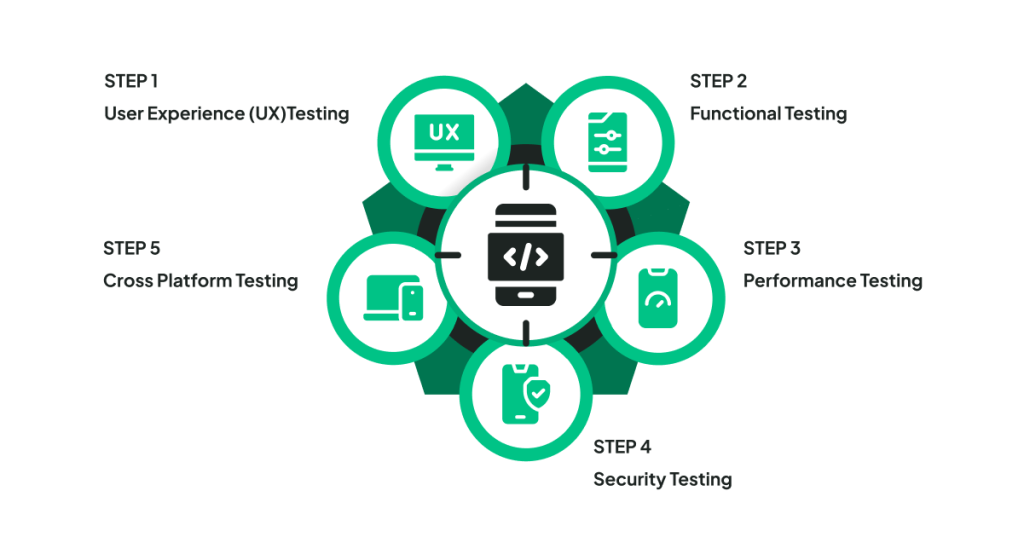
Testing is an integral part of the App Development Process. Without proper testing, even the best-designed app could fail to meet user expectations. Testing helps identify bugs, performance issues, and usability problems before the app reaches the market.
- User Experience (UX) Testing:
Helps the app become user-friendly, easy to use and aim with the expectations of users. - Functional Testing:
Checks if all the features and functionalities are working fine without any issues. - Performance Testing:
Verifies the speed, response time and stability of the app with different inputs. - Security Testing:
Detects vulnerabilities, leading to data protection and prevention of security attacks. - Cross-Platform Testing:
Ensures the app works seamlessly across different devices, screen sizes, and operating systems.
6. Deployment: Bringing Your Mobile App to Market
After Development and Testing Stages, the App Development Process shifts on to Deployment Phase. This marks the launch of your app to consumers through outlets such as The Apple App Store or Google Play. The guidelines of each submission are different, there may be some kind changes required to get it approved but every piece has mandatory conditions.
Deploying an app is not just about uploading it to the app stores. Verify if the application is configured properly for its targeted platforms. It also includes that the app is well tested for different devices, screens and versions.
Once the app is live, it is important to track how well your application is performing and ask feedback from users. A post-launch upgrade is needed in order to fix bugs and introduce new features/experiences. Successful deployment is a big milestone in the App Development Process but the key part is monitoring.
7. Post-Launch Support and Maintenance for a Successful App Development Process
The App Development Process does not stop after the launch. After launch, the app needs ongoing support and maintenance to ensure it works as expected when originally developed. Some things to remember are,
- To stay competitive in the long run, your app needs a commitment to regular updates, performance monitoring and user feedback are crucial.
- To identify and address problems as soon as they arise, developers should keep an eye on the app’s performance by monitoring metrics like user engagement, crash reports, and app health.
- Frequent enhancements and features updates keep the app fresh, competitive with other similar apps and aligns with user needs.
- An app that is kept up to date increases user retention and has a higher chance of succeeding in the market.
Common Challenges in the Mobile App Development Process and How to Address Them
The App Development Process is not easy and Challenges can erupt at any stage. Problems such as Platform Fragmentation, Security Threats or Budget Cuts are very common. A proactive approach and thorough planning can help reduce these challenges.
For example, multi-platform compatibility can be tested by testing solutions on all devices with various operating systems. During development, best practices such as encryption and multi-factor authentication can be used to mitigate security risks.
Many typical issues in the App Development Process can be successfully fixed by using an agile development methodology and iterating in response to user feedback.
Essential Things to Consider When Developing A Mobile Application
When embarking on the App Development Process, several key factors must be considered to ensure success.
- Identify Target Audience: Know who will benefit from the app and what amenities they require to customise the app’s features and user interface.
- Define Clear Goals and Objectives: Identify the core purpose of the app, its main functionality, and key metrics for measuring success.
- Choose the Right Platform: Evaluate your target users and budget to decide whether iOS app development, Android app development, or both platforms are the right choice.
- Prioritize Security: Make sure your app has the necessary security in place to safeguard customer data and comply with privacy regulations.
- Plan for Scalability: Develop the app keeping in mind that tomorrow, you may have thousands of users using your app or it would be having a dozen new features without performance getting into reflection.
How to Choose the Right Team for a Smooth App Development Process
- Select a Team with Relevant Experience: It is better to select a team that already have experience working on the type of app — native, cross-platform or hybrid apps you want because only they know what it needs when there are platform-specific requirements.
- Check Portfolio and Previous Work: Make sure to look at a team’s portfolio, as well as their previous projects (and some client testimonials) to confirm they have the expertise needed for your project.
- Focus on User Experience and Technical Skills: A strong team should have a solid understanding of backend technology, app scalability, and user experience design.
- Keep Communication Transparent : The team should keep on communicating with each other and also, update the app development process from time to time.
How Pyramidion Solutions Can Help Turn Your App Idea into a Reality
Pyramidion Solutions is the best choice for transforming your app idea into a functional, market-ready product. We provide end-to-end services for the App Development Process, starting from strategy to post-launch support.
The development team of ours is an expertise in building visually-lovely apps as well, and also functional. Whether you’re looking to build a native app for iOS or Android, or prefer a cross-platform solution, we can modify the App Development Process to meet your unique requirements.
Pyramidion Solutions has consistently launched highly successful apps and we are committed to offering the best. We ensure transparency during the App Development by taking your through every part of it.
FAQ: Common Questions About the App Development Process
1. Which company is apt to develop my mobile app idea?
Find a company that has history and good reviews from clients in the industry. Pyramidion Solutions offers top-notch services in a variety of verticals.
2. What is the Average Cost to Create a Mobile App?
App Development Process will Cost accordingly to the complexity of app features and platforms being made for. Reach out to Pyramidion Solutions for an extensive quote based on your project idea.
3. What is the Time Required to Develop a Mobile App?
App Development Process takes from a couple of months to more than a year, depending on the complexity level. This can be longer and ranges from 3 to 6 months for small-medium size apps, depending on the complexity.
4. Is My App Idea Good Enough?
You need to do market research, user validation, and ask the experts. Consult with Pyramidion Solutions to know if the Idea of your app works and get expert advice in App Development Process.

Conclusion
So, that’s the journey of an App Development Process from Beginning to End! Creating an app may seem complicated, but by following these steps and planning well, your idea can come to life successfully. Remember, it’s not just about launching; regular updates and responding to user feedback are crucial. Ready to start or refine your app journey? Partner with Pyramidion Solutions, one of the leading Mobile App Development Companies in Chennai. Get in touch today, and let us help you turn your amazing app idea into reality!

As the Director of Business Development, I have provided top-notch IT solutions for over a decade for software development, mobile application development, and blockchain development. My main work and passion lie in contributing to the business’s success through knowledge, creativity, hard work, and strong organizational skills.

